2. University, Nanyang 477061, China
2. 南阳师范学院土木建筑工程学院,河南 南阳 473061
The underwater explosion of energetic materials generates high pulse pressure formed by bubble pressure reaching dozens of GPa, and the bubble pulsation will produce such main types of damage to underwater targets as whipping and jetting[1]. A great deal of experimental data about bubble pulsation and bubble jet were obtained with high speed photography technology in the underwater explosion. The existing research results regarding underwater explosion were based on spherically symmetric movement theory which restricted a sphere charge in related experimental studies[1]. However, more cylindrical charges were used in practical engineering applications where the initiation mode was non-centro-symmetric firing. The bubble pulsation law of cylindrical charges was found different from that of sphere ones. There were some achievements in terms of underwater explosion bubble pulsation characteristics with linear and cylindrical charges in existing research. For example, Kedrinskii[2] adopted the detonating cord to simulate bubble pulsation of linear charge in underwater experiment, and the cylindrical bubble pulsation model was obtained with the Kirkwood-Bethe theory, but the results of the calculation appeared deviate at the initial period of bubble growth. Menon[3] found that the bubble collapse of detonating cord was non-spherical. Yan[4] obtained the explosion shock wave and bubble pulsation parameters with cylindrical charge of underwater explosion, and then the relationship between wave front pressure and the distance from explo sive origins was gained. Global and local dynamics of bubble generated by cylindrical charges with different detonation manner and length-diameter ratio were obtained experimentally and numerically in Huang′s work[5]. The analysis of bubble collapse and jet formation showed that the jetting process was strongly influenced by the non-spherical collapse of bubble[5].From the above research, it can be found that there exists obvious difference in terms of underwater explosion bubble pulsation characteristics among linear, cylindrical and sphere charges. Many researchers probed into the underwater explosion bubble pulsation characteristics of cylindrical and sphere charges and fruitful results were scored in this regard. However, research on the underwater explosion bubble pulsation characteristics of linear charge is yet limited. Therefore, in order to know more about the bubble pulsation characteristics of linear charge, we hereby devised an underwater explosion experiment in which the low energy detonating cord was used. With the high-speed photography technology, we studied the characteristics relating to the first bubble pulse period and the maximum diameter of low energy detonating cord in underwater explosion, with a high length-diameter ratio cylindrical charges.
2 Experimental device and measuring system 2.1 Experimental deviceA cylindrical steel container used in experiment was 26 mm×2.5 m×2 m (thickness×height×diameter) (see in Figure 1), and a circular hole was opened on it at 1.2 m from the ground on one side for shooting, where a plexiglass plate with a thickness of 40mm was mounted as a capture window. The cylindrical container was full of water when the experiment was implemented.
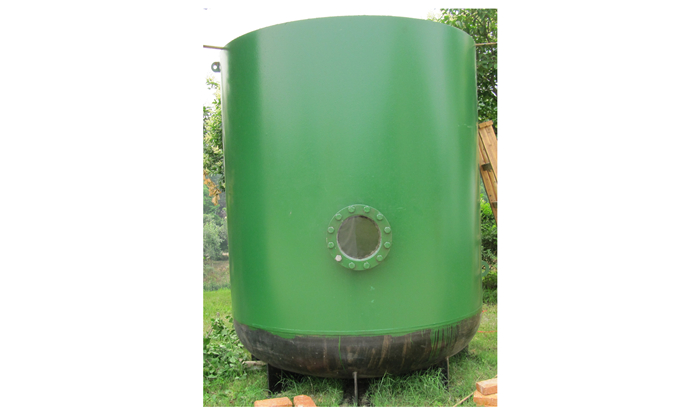
|
Fig.1 The container for the underwater explosion experimental |
The whole optical measuring experimental system was shown in Figure 2. A CamRecord 1000 from optronis, a compact stand-alone high speed recording camera with a shooting frequency of 1000~200000 fps (frame per second) and a maximum resolution of 1280 × 1024 pixels, was used. The CamRecord unit consists of a processor, camera lens and control software.

|
Fig.2 The optical measuring experimental system |
In order to adjust the detonating cord in the center of the high speed camera focus, a low energy detonating cord (1.2 m) was fixed on the support frame. A dividing ruler was laid horizontally aside the object to measure the radius of bubbles thereby captured for process the image data. A part of the low energy detonating cord was selected as the object, which gave the limited shooting scope of the high-speed camera′s capture window. The selected object was able to characterize the underwater bubble pulsation of the low energy detonating cord, because the shock wave and bubble pulse showed a good axial symmetry in this test system.
2.3 Data analysisThe photographic image of bubble diameter analysis as shown in Fig. 3. It can be seen from Fig. 3 that the bubbles captured by the image lens were not full-sized, but rather a part of the bubble diameter. AB was the horizontal dimension of camera lens and CG was cylindrical bubble diameter. The bubble diameter was two times the length of the CE. In the experiment, lens distance and low energy detonating cord distance all stand at 1.5 m.
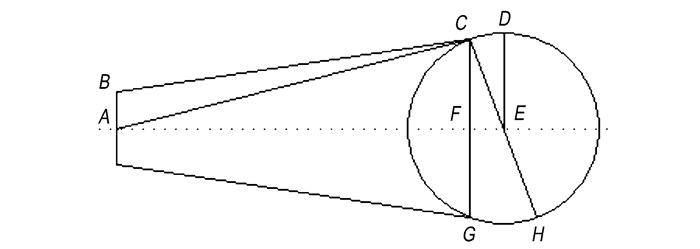
|
Fig.3 The bubble diameter analysis |
Based on the above data, the actual bubble radius could be obtained through the equations(1) and (2):
| $ EF = \frac{{AE-\sqrt {A{E^2}-4C{F^2}} }}{2} $ | (1) |
| $ CE = \sqrt {C{F^2} + E{F^2}} $ | (2) |
A 1.2 m low energy detonating cord was placed at the center of the cylindrical steel container, which was full of water. The diameter of the detonating cord was 1.8 mm and line density was 1.8 g·m-1. Shooting frequency was 2000 fps, which could ensure a 0.5 ms interval between two images and a full captured bubble pulsations.
3.2 Analysis of the experimental resultsThe bubble pulsation photographs of underwater explosion were shown in Fig. 4. From Fig. 4, five cylindrical bubble pulsation processes were captured by CamRecord in the segment, while the expansion and contraction of the underwater bubbles persisted until the bubbles disappeared.
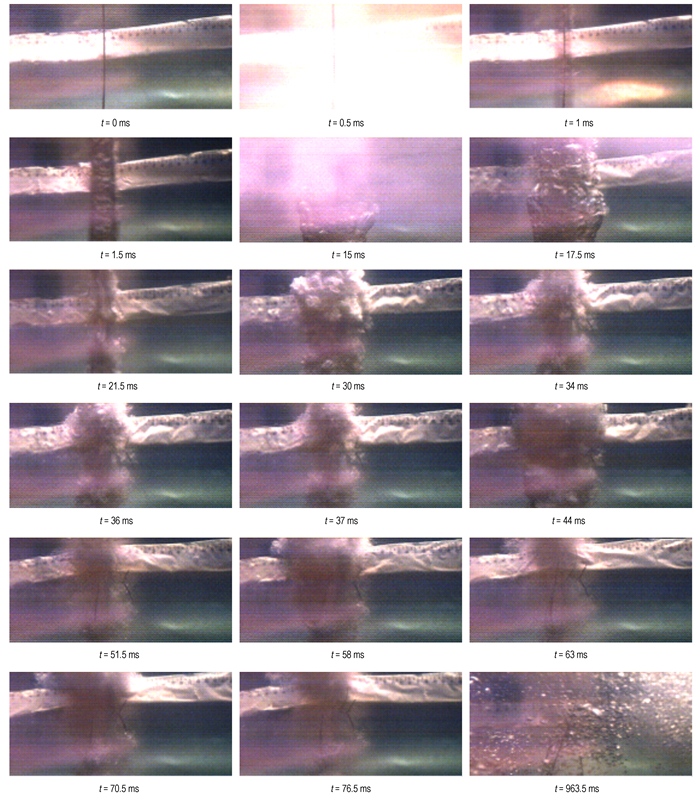
|
Fig.4 The typical images of cylindrical bubble pulsation process |
In the Fig. 4, the cylindrical bubble was formed as a result of the detonation products compressing the fluid around the cord at t=1 ms, which was followed by an increase of cylindrical bubble radius. With the increasing of bubble radius and decreasing of the gas pressure inside the bubble, the bubble expansion speed decreased. Excessive expansion of the bubble happened when the bubble pressure equilibrated with the surrounding fluid pressure. The radius of bubble reached its maximum diameter of 11.2 cm at 15 ms. Then the bubble began to shrink and the bubble radius hit its minimum at 21.5 ms, which was the end of first bubble pulse. Then the second bubble pulsation started, and the bubble pulsation period was 15.5 ms. However, the cylindrical bubble pulse shape was irregular and the outside edge of bubbles was blurry, which was mainly caused by the shell fragments of the low energy detonating cord piercing the bubbles, as confirmed by the shell fragments collected afterwards (shown in Fig. 5). As shown in Fig. 4, the second bubble pulse began to form wider at irregular bubbles traits, which was mainly due to the continuous floating of bubbles. A large number of small bubbles were still visible at 963.5 ms, which indicated that the time of bubble pulse by low energy detonating cord lasted long.
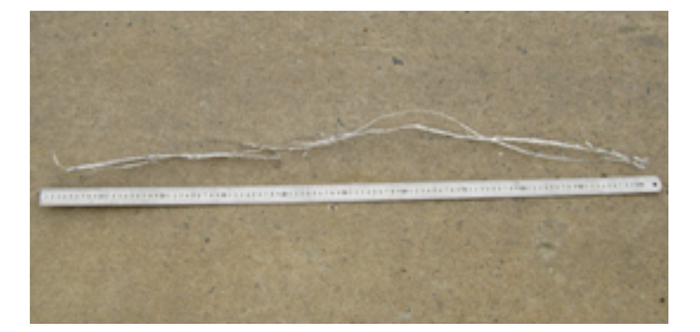
|
Fig.5 The fragments of detonating cord |
The curves between the bubble diameter of low energy detonating cord in the underwater explosion and the detonating time of the first bubble pulse in the captured segment were shown in Fig. 6. It can be found that the data points have large spans during the early stage of expansion and the end of contraction, which indicated that the bubble movement velocity was fast. The maximum radius of the bubble expansion near the bubble radius basically did not change much, which showed that the expansion and contraction of the bubble velocity was slow. The expansion time was 15ms and the contraction time was 6.5ms during the initial bubble pulsation period, so the expansion time was longer than the contraction time.
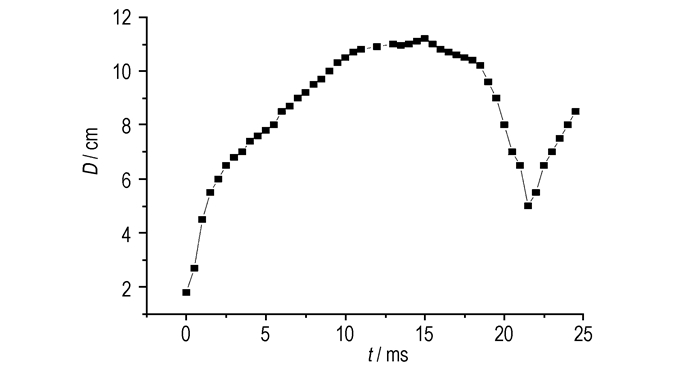
|
Fig.6 The diameter of bubble pulsation curves changing with time of the first bubble pulse |
(1) In the segment captured by CamRecord, the bubble pulse shape remained a cylindrical at the first bubbles pulsing time. Starting from the second bubbles pulsing time, the bubble pulse shape became an irregular cylinder, and the outside edge of bubbles was blurry because of the effect from shell fragments of the detonating cord.
(2) In the segment captured by CamRecord, the first bubble pulsation period was 21.5 ms and the second was 15.5 ms. At the same time, the bubble growth time was 15 ms while the contraction time was 6.5 ms in the first bubble pulsation period. The maximum diameter of bubble was 11.2 cm in the course of the bubble movement. The bubble growth time was longer than the contraction time.
| [1] |
WANG Bin, ZHANG Guang-sheng, GAO Ning, et al. Application of high-speed photography in bubble oscillation at underwater Explosion[J]. Chinese Journal of Energetic Materials(Hanneng Cailliao), 2010, 18(1): 102-106. 汪斌, 张光升, 高宁, 等. 高速摄影技术在水下爆炸气泡脉动研究中的应用[J]. 含能材料, 2010, 18(1): 102-106. |
| [2] |
Kedrinskii V K. Approximate models of one-dimensional pulsation of a cylindrical cavity in an incompressible fluid[J]. Fizika Goreniyai Vzryva, 1976, 12(5): 768-773. |
| [3] |
Menon S. Experimental and numerical studies of underwater explosions. Annual report for the office of naval research[R]. Atlanta, Georgia, 1996.
|
| [4] |
YAN Shi-long. Measurement of the explosion energy of the centralized charge and the linear charge underwater[J]. Explosive Materials, 2003, 32(5): 23-27. 颜事龙. 集中药包与条形药包水下爆炸能量测试[J]. 爆破器材, 2003, 32(5): 23-27. |
| [5] |
HUANG Chao, WANG Bin, ZHANG Yuan-ping, et al. Behaviors of bubble jets induced by underwater explosion of cylindrical charges under free-field conditions[J]. Explosion and Shock Waves, 2011, 31(3): 263-267. 黄超, 汪斌, 张远平, 等. 柱形装药自由场水中爆炸气泡的射流特性[J]. 爆炸与冲击, 2011, 31(3): 263-267. |
| [6] |
JIA Hu, Shen Zhao-wu. Underwater sound characteristics of metal-clad detonating cords[J]. Explosion and Shock Waves, 2011, 31(4): 428-432. 贾虎, 沈兆武. 金属导爆索的爆炸水声特性[J]. 爆炸与冲击, 2011, 31(4): 428-432. |

An underwater explosion experiment low energy detonating cord was carried out by high-speed photography technology.




